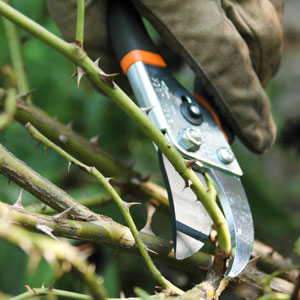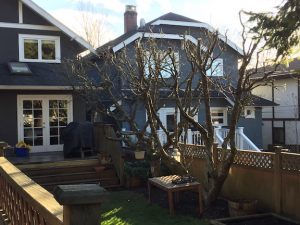Are you wondering what needs to be done in the garden at this time of year? Here’s what we recommend needs attention in Late Winter. These gardening tasks are usually done in February, or as early as January in milder climates.
 Rose Pruning. Pruning roses back to a small framework is very important for getting gorgeous blossoms in the summer. After the threat of hard frost has passed, discover the effects of cutting back your roses. Leave three buds on the end stem of your framework, or cut canes right down to the ground also leaving three buds. A great tip is to have the top bud facing the direction you want the new branch to grow.
Rose Pruning. Pruning roses back to a small framework is very important for getting gorgeous blossoms in the summer. After the threat of hard frost has passed, discover the effects of cutting back your roses. Leave three buds on the end stem of your framework, or cut canes right down to the ground also leaving three buds. A great tip is to have the top bud facing the direction you want the new branch to grow.
LAWN CARE: Aeration and de-thatching. Adding air to the roots of your lawn through aeration greatly improves the health of your turf grass. You can rent an aerator at your local equipment rental shop, the machine will do the job of removing plugs of soil. Leave the plugs on the lawn and over time they will fall apart. There are also mechanical aerators that can be used. It is a hand tool consisting of aerating tines that spin at the base of a long handle.
De-thatching is also known as power raking. The goal is to remove dead grass blades that have built up as thatch. This allows more light to reach your turf grass plants. You can rake your lawn aggressively by hand or rent a de-thatcher from your local equipment rental shop.
Hedges:
Winter Damage Repair. Get hedges back in shape. Many winter snow falls wreak havoc on our hedges. On cedars, many of the bent branches can be tied back into place. English laurels, yew hedges or other typically square hedges suffer from broken branches and may require some hard pruning to re-create their original form. Time to get out the chainsaw! Fortunately, both laurels and yews will sprout new leaves and your hedge will recover quickly.
Hedge Trimming:

Formal hedge shape, straight sides and top with rounded corners
In mild climate areas such as the Pacific Northwest, laurel hedges can be trimmed and shaped as early as January. Want to get a jump start on having a shapely hedge for the remainder of the spring? Then trim your hedges to get them into shape.
Prune deciduous plants that are dormant right now. Cut them this time of year to invigorate growth in spring and summer. (Do not do this if you want your plants to be smaller). Buddleja (butterfly bush) loves being hacked back in early spring!
The following plants flower on new wood, or branches that grow during the current growing season. The plant can be cut back before growing starts in the spring.
- Abelia
- Barberry (Berberis)
- Bluebeard (Caryopteris)
- Butterfly bush (Buddleja)
- Clematis (late-flowering group)
- Heath & Heather (Calluna and Erica)
- Fuchsia (hardy varieties)
- Rose of Sharon (Hibiscus)
- Honeysuckle (Lonicera)
- Lavender (can also be cut back in fall in Vancouver because of our milder climate)
- Mallow (Malva) Can be cut back by half in May to make Mallow more compact and bushy.
- Shrubby cinquefoil (Potentilla)
- Red-twig dogwood (Cornus)
- Roses
- Sage (Salvia)
 Prune dormant trees.
Prune dormant trees.
This includes maples and birches. Maples and birches have a heavy sap flow in spring, so to invigorate growth in the summer, be sure to prune in winter before any buds start forming.
When deciding at what time of year to prune fruit trees, it depends on how you want the tree to react. If you prune in winter, the tree will respond with vigorous growth in summer. If you prune in summer, the effect will be to suppress growth allowing you to control the size of the tree. Some clients like to have trees pruned in winter so they get a flush of growth that will cover views of neighbour’s decks or unslightly construction sites in the vicinity.
Most apple trees bear fruit on second year wood. Leaf buds form the first year of growth, and then in the second year, fruit buds will form on those same branches. This winter we have already pruned some apple trees in Vancouver backyards, and our clients know that they will have to wait a couple of summers before they get any fruit.
